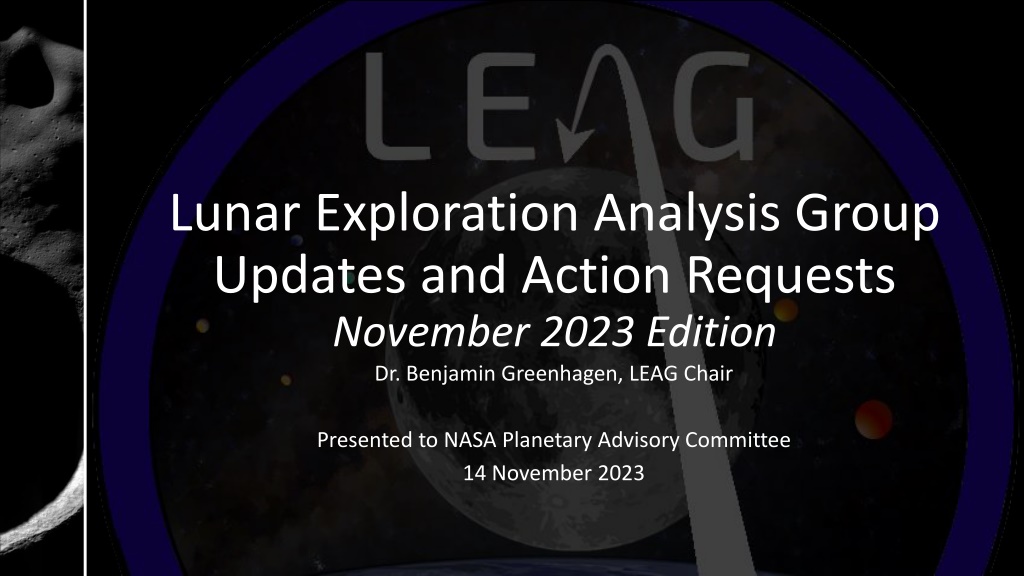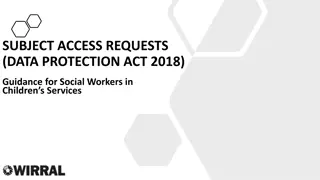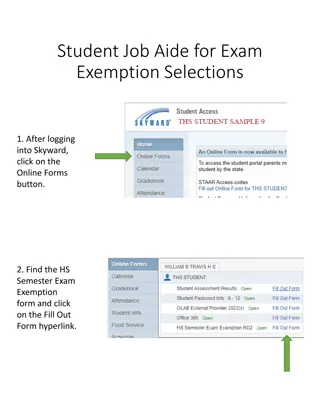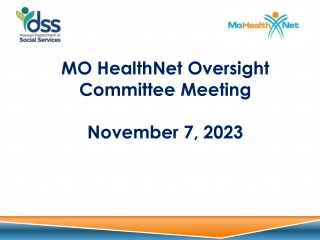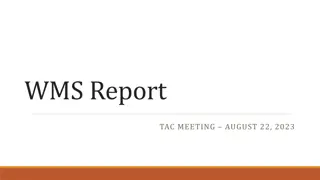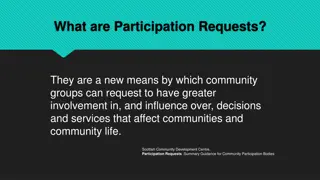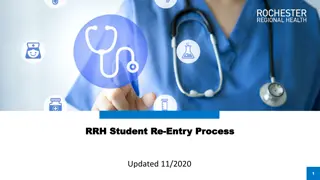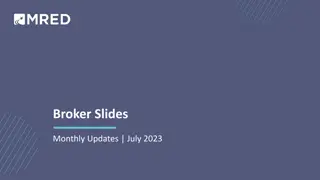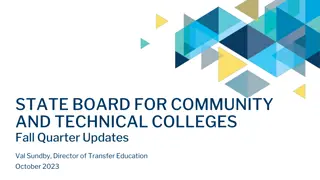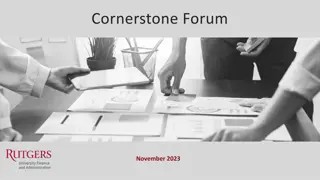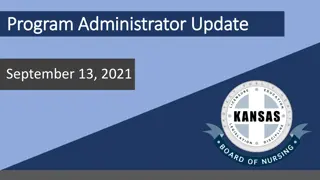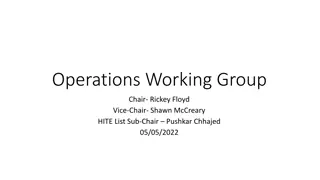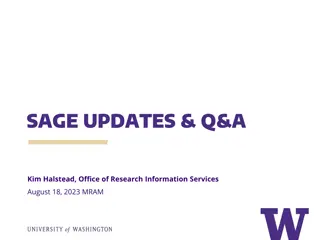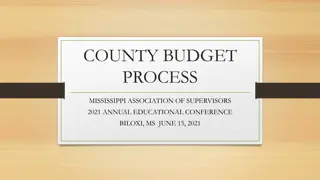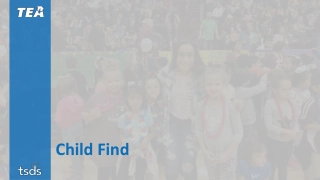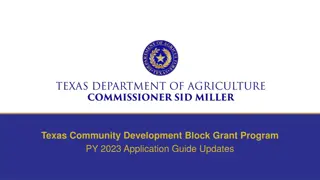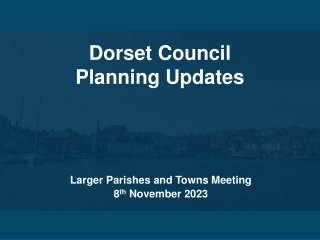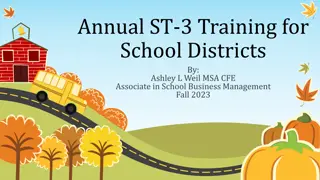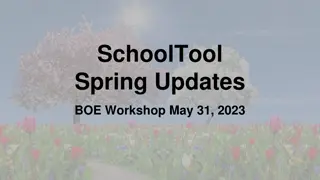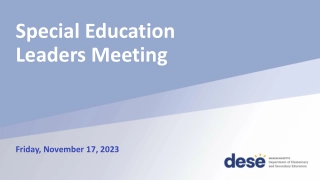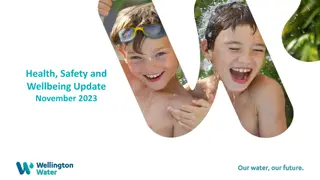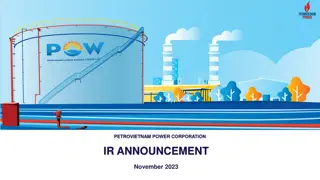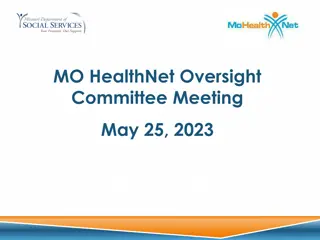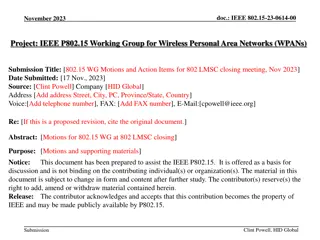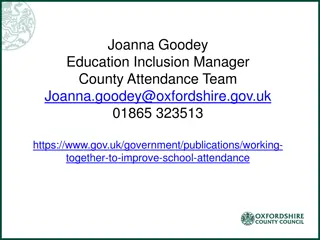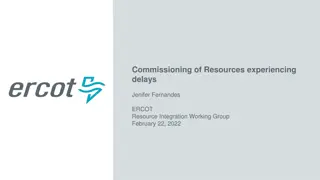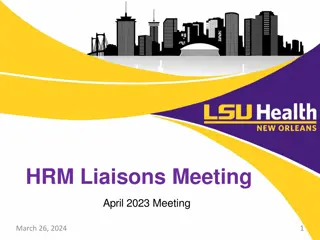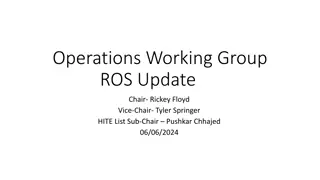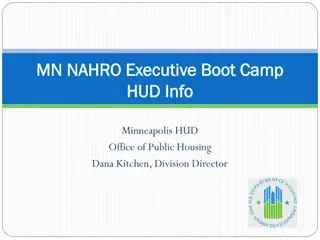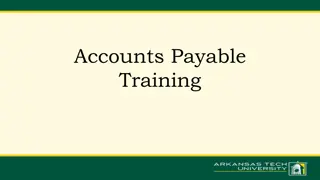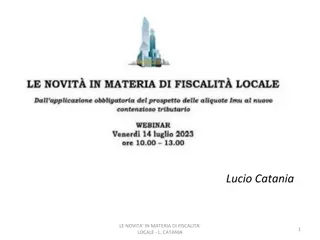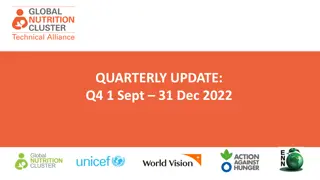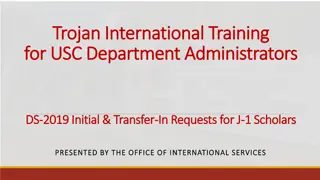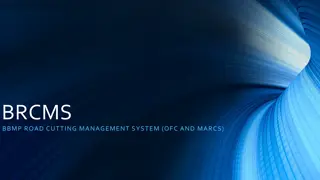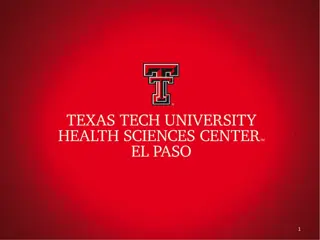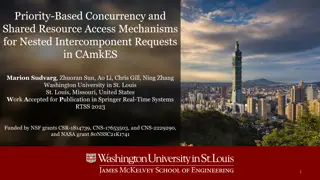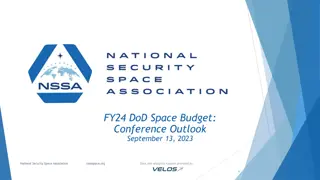Latest Updates and Action Requests from LEAG - November 2023 Edition
LEAG presents exciting developments in lunar activities including team selections, upcoming commercial moon landings, and initiatives towards an International Lunar Year. Additionally, LEAG responds to a NASA request regarding the maintenance of the Mean Earth Coordinate System for the Moon, emphasizing the benefits of its continued use.
Download Presentation

Please find below an Image/Link to download the presentation.
The content on the website is provided AS IS for your information and personal use only. It may not be sold, licensed, or shared on other websites without obtaining consent from the author. Download presentation by click this link. If you encounter any issues during the download, it is possible that the publisher has removed the file from their server.
E N D
Presentation Transcript
Lunar Exploration Analysis Group Updates and Action Requests November 2023 Edition Dr. Benjamin Greenhagen, LEAG Chair Presented to NASA Planetary Advisory Committee 14 November 2023 Dr. Ben Greenhagen, on behalf of the Lunar Exploration Analysis Group Given to the NASA Planetary Science Advisory Committee November 14, 2023
Excitement for Lunar Activities Headline Lunar Activities Since Summer: SSERVI Selected Five CAN 4 Teams Artemis III Geology Team Selected PRISM-3 DIMPLE Selected India landed on the Moon! Looking Forward in the Coming Months: Two (!) Commercial Lunar Payload Services (CLPS) landings on the Moon Astrobotic Peregrine Mission 1 (Dec. 2024) to Sinus Viscositatis with 5 NASA-hosted payloads Intuitive Machines IM-1 (Jan. 2024) to Malapert A with 6 NASA-hosted payloads AO releases for PRISM SALSA, Instruments for Lunar Terrain Vehicle (LTV) & Artemis IV Selections for Artemis III Deployed Instruments & LTV industry provider Dr. Ben Greenhagen, on behalf of the Lunar Exploration Analysis Group Given to the NASA Planetary Science Advisory Committee November 14, 2023
LEAG is Helping the Community Organize an International Lunar Year Towards the End of this Decade LEAG is forming a community coordination group to help communicate and align activities Near-term goal to identify big science enabled by ILY An ILY during the timeframe 2027-2030 could: Prompt new multilateral coordination relevant to enduring human and robotic presence at the Moon Promote long-term safety and sustainability in exploration and utilization activities at the Moon Foster coordination between scientific, educational, and commercial space communities Promote communication and coordination between operators in Cislunar space ILY requires a concerted, grassroots effort from the lunar science and exploration communities to get off the ground Intent is to model after successful past Science Years, such as the IGY 1957-58 Community Sign-up Form For more info contact either: LEAG ILY Lead, Erica Jawin (JawinE@si.edu) LEAG Chair, Ben Greenhagen (Benjamin.Greenhagen@jhuapl.edu) Dr. Ben Greenhagen, on behalf of the Lunar Exploration Analysis Group Given to the NASA Planetary Science Advisory Committee November 14, 2023
LEAG responded to a NASA White Paper Request for Merits of Maintaining Mean Earth (ME) Coordinate System for the Moon Rapid response to NASA request for white paper Pulled passionate expertise from LEAG Community to respond Brent Archinal, Caleb Fassett, Lisa Gaddis, Trent Hare, Erick Malaret, Lillian Ostrach, Ryan Park Recommendation to continue ME for lunar mapping, not Principal Axis (PA) ME is internationally accepted standard system, and used for centuries Several PB of data from NASA and international missions in ME plus products derived: Maps, mosaics, databases, publications PA system primarily important for dynamical purposes, but not more accurate nor simpler Change to PA would risk confusion and need significant resources Potential for major consequences for future lunar missions Updating and reprocessing all lunar data and creating new maps in PA People, time, $$$ Difference in ME and PA coordinates of a point is at least 100 s of m Dr. Ben Greenhagen, on behalf of the Lunar Exploration Analysis Group Given to the NASA Planetary Science Advisory Committee November 14, 2023
LEAG Annual Meeting Review and Findings September 20-22, 2023 Johns Hopkins Applied Physics Laboratory Laurel, MD/Virtual Featured Topics NASA HQ Updates Moon to Mars Artemis, PRISM, Endurance Updates / Current Mission Updates DEIA (focus on Inclusion Plans) Advances in Support of Exploration and Surface Operations (Posters) Instrument Concepts and Payloads (Posters) Scientific Investigations of Current and Future Landing Sites (Posters) Awards John Gruener, LEAG Service Award Jatan Mehta, Early Career Featured Presentation Dr. Ben Greenhagen, on behalf of the Lunar Exploration Analysis Group Given to the NASA Planetary Science Advisory Committee November 14, 2023
LEAG Annual Meeting Review and Findings (Top 6) 1. The LEAG and MEPAG communities should be active partners in the development and refinement of the Moon to Mars (M2M) Architecture goals and objectives. 2. LEAG affirms the continued importance of inclusion plans, however, LEAG strongly encourages NASA to develop and publish a rubric to guide plan development and evaluation. 3. LEAG encourages NASA to actively engage with LEAG and the Mapping and Planetary Spatial Infrastructure Team (MAPSIT) to find mechanisms to fund, support, and facilitate a wide-reaching systemic lunar mapping campaign within the next 12 months. 4. LEAG recognizes the importance of scope and scale of the Endurance mission concept as transformational in lunar and planetary science, and strongly encourages an implementation that does not diminish the existing mission concept and encourages NASA to assemble a formal Science Definition Team (SDT) that is inclusive of the lunar science community. 5. LEAG encourages collection and dissemination of both scientific and technical information related to the successes and challenges of the many cubesats launched in fall 2022. 6. The LEAG Commercial Advisory Board (CAB) identified findings in three topics: (I) Commercial Lunar Payload Service (CLPS), (II) Moon to Mars (M2M) Architecture, and (III) regulatory challenges on lunar infrastructure development: Note: Full Summary and Findings in Backup Dr. Ben Greenhagen, on behalf of the Lunar Exploration Analysis Group Given to the NASA Planetary Science Advisory Committee November 14, 2023
LEAG Annual Meeting Review and Findings 1. The LEAG and MEPAG communities should be active partners in the development and refinement of the Moon to Mars (M2M) Architecture goals and objectives. We request that NASA ensures these groups, as representatives of the scientific community, are actively involved during the revision and refinement of the M2M Architecture. Together these groups should facilitate the flow of ideas and feedback regarding the M2M Architecture to NASA. We appreciate NASA s demonstrated commitment to incorporating feedback from industry and academic partners through the recent announcement of the 2024 M2M Architecture Workshop, but strongly encourage ESDMD to actively engage the scientific community throughout the year rather than rely on once-per-year workshops. LEAG suggests that NASA releases a timeline for the projected revisions of the Architecture Definition Document (ADD) updates to the community and ensure the lunar and Martian communities have ample time to review the ADD prior to the upcoming workshop. LEAG further suggests that NASA conduct this workshop as a hybrid meeting with both in person and online participation. LEAG recognizes that many qualified interested individuals, especially early career researchers, may lack travel support for an in person meeting not directly related to funded grant work. A hybrid M2M Architecture Workshop would ensure meaningful engagement with the broadest possible cross section of academia and industry. Dr. Ben Greenhagen, on behalf of the Lunar Exploration Analysis Group Given to the NASA Planetary Science Advisory Committee November 14, 2023
LEAG Annual Meeting Review and Findings 2. LEAG affirms the continued importance of inclusion plans, however, LEAG strongly encourages NASA to develop and publish a rubric to guide plan development and evaluation. The inclusion plan pilot program is an important step towards embedding Diversity, Equity, Inclusion, and Accessibility (DEIA) principles within the structure of the community. However, the implementation and assessment of these plans has often resulted in community confusion. Although NASA has released a number of documents, and also hosted a workshop relating to inclusion plan best practices, the suggestions provided by these materials have not translated to successful inclusion plans, and reviews have often provided contradictory or inconsistent suggestions. While LEAG recognizes NASA s reticence in providing a template or check list for inclusion plans, which should be tailored to specific team needs, the development of an assessment rubric would provide a significant step forward in the standardization of proposer expectations and reviewer assessment. Dr. Ben Greenhagen, on behalf of the Lunar Exploration Analysis Group Given to the NASA Planetary Science Advisory Committee November 14, 2023
LEAG Annual Meeting Review and Findings 3. LEAG encourages NASA to actively engage with LEAG and the Mapping and Planetary Spatial Infrastructure Team (MAPSIT) to find mechanisms to fund, support, and facilitate a wide-reaching systemic lunar mapping campaign within the next 12 months. Historically, the community provided significant essential support for the Surveyor and Apollo landings through concentrated geologic mapping efforts; we encourage a similar effort for the Artemis program and other upcoming lunar missions (e.g., CLPS) to include various map types (e.g., geologic, resource, hazard, tactical, etc.) at multiple scales. This corresponds to a similar finding from MAPSIT at the June PAC meeting. We encourage an examination of current specific mapping needs, including datasets and accessible formats; tools and software; and current and potential future funding pathways and opportunities. Dr. Ben Greenhagen, on behalf of the Lunar Exploration Analysis Group Given to the NASA Planetary Science Advisory Committee November 14, 2023
LEAG Annual Meeting Review and Findings 4. LEAG recognizes the importance of scope and scale of the Endurance mission concept as transformational in lunar and planetary science, and strongly encourages an implementation that does not diminish the existing mission concept and encourages NASA to assemble a formal Science Definition Team (SDT) that is inclusive of the lunar science community. The return of samples from South-Pole Aitken Basin will answer critical questions about chronology and planetary evolution throughout the Solar System. Furthermore, the Planetary Science and Astrobiology Decadal Survey 2023-2032 presented a 2000 km traverse across some of the most geologically diverse terrain on the Moon, offering a unique opportunity to study the chemistry and structure of the Moon, that is, in whole, far greater than the sum of its individual investigations. A formal SDT will have enormous value in evaluating the science goals and optimal payload for Endurance. When forming this SDT, it will be crucial to have direct participation from the lunar science community in order to capture the breadth of possible science investigations and ideal instrument payload, thus maximizing the science return. Lastly, LEAG endorses the draft findings of the August 2023 Endurance Science Workshop. Dr. Ben Greenhagen, on behalf of the Lunar Exploration Analysis Group Given to the NASA Planetary Science Advisory Committee November 14, 2023
LEAG Annual Meeting Review and Findings 5. LEAG encourages collection and dissemination of both scientific and technical information related to the successes and challenges of the many cubesats launched in fall 2022. As noted by Lori Glaze in reference to LunaH-Map, these small missions are inherently risky, as they are designed to test the bounds of what can be achieved with lower-cost missions. However, cubesats remain a compelling option for investigations beyond low Earth orbit, and are theoretically capable of addressing a range of priority lunar science questions from orbit as outlined in LEAG s recent Continuous Lunar Orbital Capabilities Specific Action Team (CLOC-SAT) report. Given NASA investments in BioSentinel, CuSP, IceCube, NEA Scout, and Lunar Flashlight, as well as investments made by other space agencies, industry, and academia, there remains enormous potential to leverage the experiences gained. Future successes will rely on building on past lessons learned. Dr. Ben Greenhagen, on behalf of the Lunar Exploration Analysis Group Given to the NASA Planetary Science Advisory Committee November 14, 2023
LEAG Annual Meeting Review and Findings 6. The LEAG Commercial Advisory Board (CAB) identified findings in three topics: (I) Commercial Lunar Payload Service (CLPS), (II) Moon to Mars (M2M) Architecture, and (III) regulatory challenges on lunar infrastructure development: I. The CAB appreciates NASA s continued support for CLPS and eagerly awaits future opportunities to provide the next generation of CLPS capabilities. The CAB continues to recommend a NASA-led effort to develop a CLPS capabilities roadmap that reflects the lunar community s objectives. Such a roadmap will allow CLPS providers to invest in developing new capabilities on a timeline commensurate with NASA s needs. Involvement of the CLPS providers and the CAB in this roadmap development would assist in feasibility and timeline development. II. The CAB encourages NASA to review how CLPS capabilities could help achieve lunar Infrastructure objectives as outlined in NASA s Moon to Mars Strategy and Objective Development document. Considering CLPS capabilities to advance these technology developments would leverage existing investments in CLPS, and potentially offer additional lunar payload capacity for lunar science and exploration opportunities. III. The CAB encourages NASA to work with industry, CLPS providers, and regulatory partners such as the Department of Energy (DOE) to plan a regulatory path towards the implementation of alternative energy sources on the lunar surface, including nuclear-powered payloads. Disallowing certain lunar energy technology development risks hindering future lunar infrastructure development. Dr. Ben Greenhagen, on behalf of the Lunar Exploration Analysis Group Given to the NASA Planetary Science Advisory Committee November 14, 2023
Additional LEAG Slides for the PAC New LEAG Executive Committee Responding to a NASA White Paper Request for Science from Artemis Base Camp Coordination with other AGs: Joint LEAG-ExMAG SAT & Working with MEPAG on M2M 2023 Annual Meeting of the Lunar Exploration Analysis Group: Summary and Findings Summary of Cross-Cutting Meeting Topics in Discussions and Questions Notes of Appreciation and Gratitude towards NASA Actionable Findings from the 2023 Annual Meeting of the Lunar Exploration Analysis Group Dr. Ben Greenhagen, on behalf of the Lunar Exploration Analysis Group Given to the NASA Planetary Science Advisory Committee November 14, 2023
New LEAG Executive Committee (October 1, 2023) Chair Emeritus Chair Science Human Exploration Technology Astrophysics Liaison Equity, Diversity, & Inclusion < open > Operations Strategic Roadmap Workforce Development At-Large Member At-Large Member At-Large Member Chair, CAB Benjamin Greenhagen, JHU APL Amy Fagan, Western Carolina Univ. Timothy Glotch, Stony Brook Univ. Jacob Richardson, NASA GSFC Jose Hurtado, Univ. of Texas, El Paso < open > Ex Officio Members Sarah Noble, NASA SMD Jacob Bleacher, NASA ESDMD Andrew Petro, NASA STMD Lisa Gaddis, LPI Gregory Schmidt, SSERVI Lauren Jozwiak, JHU APL < vacant for FY24 > Tabb Prissel, NASA JSC Kerri Donaldson Hanna, Univ. Central Florida Erica Jawin, Smithsonian Institute Sarah Valencia, NASA GSFC Stephen Indyk, Honeybee Robotics Open positions and instructions are described on the main LEAG website: https://www.lpi.usra.edu/leag/ These positions will remain open until filled. Application reviews will begin on December 1st so please email your CV and short personal statement by November 30th to the LEAG Chair Dr. Ben Greenhagen, on behalf of the Lunar Exploration Analysis Group Given to the NASA Planetary Science Advisory Committee November 14, 2023
LEAG is responding to a NASA White Paper Request for Science from Artemis Base Camp Responding to suggestion that LEAG should collect white papers about the science objectives to be achieved at the Base Camp and deliver them to NASA Comment from Dr. Nicky Fox (AA of SMD) at May 2023 Lunar Surface Science Workshop (LSSW) Later clarified with LEAG NASA HQ reps providing feedback on the types of information desired Long-running topic of interest to LEAG community Topic at both 2020 and 2023 LEAG Annual Meetings Determined the best plan to implementation is to organize white paper topics at a future LSSW tentatively scheduled for April 3, 2024 Breakout session centered around science themes Identify principal and supporting authors Goal to submit a package of ~5 white papers by end of May 2024 Dr. Ben Greenhagen, on behalf of the Lunar Exploration Analysis Group Given to the NASA Planetary Science Advisory Committee November 14, 2023
LEAG is Coordinating with other AGs: Joint LEAG-ExMAG SAT & Working with MEPAG on M2M Joint LEAG-ExMAG SAT will examine three main topics: (1) Volatile Samples and Cold Curation, (2) Nominal Samples, and (3) Sample Data Infrastructure Three LEAG ExComm Members are Supporting: Sarah Valencia (Nominal Samples, Vice Chair), Tim Glotch (Sample Data Infrastructure, Vice-Chair), Amy Fagan (Ex Officio) Vice Chairs will be supported in their topics by four members of the community and a graduate student executive summary; selections are underway now. LEAG and MEPAG are investigating ways improve coordination given the alignment of our communities through the Moon to Mars Architecture MEPAG will provide the LEAG ExComm with a briefing of their recent Mars science objectives for human exploration tiger team MEPAG and LEAG are exploring opportunities for joint workshops to coordinate feedback to the annual M2M review cycle Lessons-learned from the well-established Mars Science Goals process will feed into a lunar science goals process to be kicked off later this month Dr. Ben Greenhagen, on behalf of the Lunar Exploration Analysis Group Given to the NASA Planetary Science Advisory Committee November 14, 2023
2023 LEAG Annual Meeting: Cross-Cutting Topics and Ideas from Discussions and Questions NASA Budget Concerns Working with BPS Future of the Artemis Program Lessons Learned from PRISM (and More) Future of the PRISM Program Artemis, Ethics and Society Note: Topics expanded in following 3 slides Dr. Ben Greenhagen, on behalf of the Lunar Exploration Analysis Group Given to the NASA Planetary Science Advisory Committee November 14, 2023
2023 LEAG Annual Meeting: Cross-Cutting Topics and Ideas from Discussions and Questions NASA Budget Concerns The LEAG community expressed concern regarding NASA s budget situation both with respect to the projects within the Lunar Discovery and Exploration Program (LDEP) and competitive planetary opportunities through the Planetary Science Division (PSD). The community was advised to expect no opportunities for SIMPLEx, Discovery, or New Frontiers for at least 2 years. Despite these delays, the community remains generally optimistic and will continue to work through LEAG to respond to the Planetary Science and Astrobiology Decadal Survey 2023-2032 to facilitate a structured approach to setting science goals and measurement objectives at the Moon, led by the lunar science community. Working with BPS The LEAG community expressed an openness to work with the Biological and Physical Sciences (BPS) Division as they expand their focus from LEO investigations to include more activities in lunar vicinity and from the lunar surface. The Moon is comprehensively included in the recently released Thriving in Space: Ensuring the Future of Biological and Physical Sciences Research: A Decadal Survey for 2023-2032 (2023) and the community looks forward to more opportunities to engage with BPS in the same way that it already engages with the NASA s Heliophysics and Astrophysics Divisions. Dr. Ben Greenhagen, on behalf of the Lunar Exploration Analysis Group Given to the NASA Planetary Science Advisory Committee November 14, 2023
2023 LEAG Annual Meeting: Cross-Cutting Topics and Ideas from Discussions and Questions Future of the Artemis Program The progression of Artemis missions was presented in great detail and the community expressed excitement regarding NASA plans to systematically build capabilities as the program progresses. Building off the highly successful Artemis I mission, NASA will add human spaceflight with Artemis II, south polar lunar landing with Artemis III, Gateway with Artemis IV, Lunar Terrain Vehicle with Artemis V, and a pressurized rover with Artemis VI. The community stands ready to contribute to all of these missions through science, payloads, and enabling technologies. Lessons Learned from PRISM (and More) There are many lessons learned between the six selected PRISM payloads, each of which is at a unique point in their development. The LEAG annual meeting presented an opportunity for detailed community interactions with each of these teams and several CLPS providers to better convey lessons learned. This represented an important step towards coordination between current and future PRISM participants within the lunar community to maximize future science return. Separately, lessons learned from Lunar Flashlight provided a significant example of how we can learn from technical challenges to enable future opportunities. Dr. Ben Greenhagen, on behalf of the Lunar Exploration Analysis Group Given to the NASA Planetary Science Advisory Committee November 14, 2023
2023 LEAG Annual Meeting: Cross-Cutting Topics and Ideas from Discussions and Questions Future of the PRISM Program The LEAG community expressed some concern regarding the future of the PRISM program following the announcement of a delay of PRISM-4 to ROSES 2024. While there was clear community support for the announced PRISM Stand Alone Landing Site Agnostic (SALSA) opportunity to be released this fall, much more engagement is needed between NASA and the community regarding details of future PRISM opportunities, including the scope and timing of opportunities, well in advance of their draft AO release so that all members of the community can better prepare; this is in agreement with past LEAG and LEAG CAB findings of a desire for a PRISM roadmap . Artemis, Ethics and Society The LEAG community supported the conclusions described in the Artemis, Ethics and Society: Synthesis from a Workshop . This workshop identified and addressed a myriad of important ethical issues and offered potential mitigation pathways that should be considered as efforts for Artemis and Moon to Mars are formulated, while also keeping in mind that a balance is required (e.g., how to allow resource extraction and utilization while being respectful of different cultures and positions). Dr. Ben Greenhagen, on behalf of the Lunar Exploration Analysis Group Given to the NASA Planetary Science Advisory Committee November 14, 2023
2023 LEAG Annual Meeting: Notes of Appreciation and Gratitude towards NASA Maintaining Balance Between Ongoing Projects and Future Work Lunar Trailblazer Ride-share Science as a Pillar of Exploration Science Support for Artemis Thoughtful Evolution of Opportunities as Capabilities Advance Continued Development of Endurance-A Utilizing the LEAG CLOC-SAT Report Note: Topics expanded in following 3 slides Dr. Ben Greenhagen, on behalf of the Lunar Exploration Analysis Group Given to the NASA Planetary Science Advisory Committee November 14, 2023
2023 LEAG Annual Meeting: Notes of Appreciation and Gratitude towards NASA Maintaining Balance Between Ongoing Projects and Future Work LEAG appreciates efforts by NASA leadership to protect research and analysis (R&A) funding, flight projects such as the Lunar Reconnaissance Orbiter (LRO), and projects already selected for development (e.g., VIPER, CLPS payloads) from Agency-wide cost-cutting. Every competitively- selected mission deserves a fair chance to develop and follow a path to flight. We recognize the difficulties in balancing these ongoing projects with future work. Furthermore, LEAG applauds NASA for continuing to advance lunar science and exploration in the past year through the competitive selection of R&A grants through the Lunar Data Analysis Program (LDAP), instrument maturation grants through DALI, the U.S.-contribution to the Canadian Space Agency small lunar rover mission, PRISM-3, five SSERVI CAN-4 teams, Artemis III Geology Team, and soon the Artemis III Deployed Instruments selections. Lunar Trailblazer Ride-share LEAG applauds the successful effort to confirm Lunar Trailblazer as a ride-share on the Intuitive Machines IM-2 mission. This will enable critical targeted observations from Lunar Trailblazer to be collected significantly earlier than otherwise projected. These timely observations will be used to address important science questions and aid in the selection of landing sites for both robotic and crewed missions. Dr. Ben Greenhagen, on behalf of the Lunar Exploration Analysis Group Given to the NASA Planetary Science Advisory Committee November 14, 2023
2023 LEAG Annual Meeting: Notes of Appreciation and Gratitude towards NASA Science as a Pillar of Exploration LEAG applauds NASA s commitment to science as one of the pillars of exploration and appreciates efforts to draft an Integrated Lunar Science Strategy. The community eagerly awaits opportunities to review the draft Strategy document and provide feedback in the coming months. Science Support for Artemis LEAG applauds efforts from NASA to build on its internal science teams to provide comprehensive science support to Artemis through competitively-selected science teams, participating scientists, and instrument teams beginning with Artemis III. In addition, LEAG appreciates the appointment of a Project Scientist to the important Artemis II mission. Furthermore, the lunar community eagerly awaits information on lunar science and instrument opportunities that utilize Gateway beginning with Artemis IV. Thoughtful Evolution of Opportunities as Capabilities Advance The LEAG community appreciates NASA implementing innovative solutions for future lunar surface missions such as expanding CLPS-provided services to include mobility and night survival. Furthermore, the community recognizes the challenges of designing instrumentation to be deployed by astronauts on the lunar surface and thanks NASA for the willingness to adapt future Artemis Deployed Instrument calls over time to provide additional technical guidance, development time, and lessons learned from review of the Artemis III Deployed Instruments proposals. Dr. Ben Greenhagen, on behalf of the Lunar Exploration Analysis Group Given to the NASA Planetary Science Advisory Committee November 14, 2023
2023 LEAG Annual Meeting: Notes of Appreciation and Gratitude towards NASA Continued Development of Endurance-A The LEAG community appreciates NASA s commitment to develop the Endurance-A South Pole Aitkin basin sample return mission through additional pre-phase A concept study efforts, support for the Endurance Science Workshop, and the planned establishment of an Endurance Science Definition Team. These actions make it clear that NASA values Endurance and its science objectives as prioritized in the Decadal Survey as LDEP s top priority. Utilizing the LEAG CLOC-SAT Report LEAG appreciates NASA s commitment to include the analysis provided by our Continuous Lunar Orbital Capabilities Specific Action Team (CLOC-SAT) final report in the formulation of future lunar orbital missions. Specifically, NASA directed LEAG to provide mission-specific CLOC-SAT priorities for the pre-Phase A Lunar Exploration and Science Orbiter (LExSO) concept study. We eagerly await the results of that study and will provide feedback on its alignment to the identified community priorities. Furthermore, the community looks forward to learning more about future lunar orbital opportunities in general. Dr. Ben Greenhagen, on behalf of the Lunar Exploration Analysis Group Given to the NASA Planetary Science Advisory Committee November 14, 2023
2023 LEAG Annual Meeting: Actionable Findings (1 6) 1. The LEAG and MEPAG communities should be active partners in the development and refinement of the Moon to Mars (M2M) Architecture goals and objectives. 2. LEAG affirms the continued importance of inclusion plans, however, LEAG strongly encourages NASA to develop and publish a rubric to guide plan development and evaluation. 3. LEAG encourages NASA to actively engage with LEAG and the Mapping and Planetary Spatial Infrastructure Team (MAPSIT) to find mechanisms to fund, support, and facilitate a wide-reaching systemic lunar mapping campaign within the next 12 months. 4. LEAG recognizes the importance of scope and scale of the Endurance mission concept as transformational in lunar and planetary science, and strongly encourages an implementation that does not diminish the existing mission concept and encourages NASA to assemble a formal Science Definition Team (SDT) that is inclusive of the lunar science community. 5. LEAG encourages collection and dissemination of both scientific and technical information related to the successes and challenges of the many cubesats launched in fall 2022. 6. The LEAG Commercial Advisory Board (CAB) identified findings in three topics: (I) Commercial Lunar Payload Service (CLPS), (II) Moon to Mars (M2M) Architecture, and (III) regulatory challenges on lunar infrastructure development: Dr. Ben Greenhagen, on behalf of the Lunar Exploration Analysis Group Given to the NASA Planetary Science Advisory Committee November 14, 2023
2023 LEAG Annual Meeting: Actionable Findings (7 11) 7. LEAG encourages NASA to maintain remaining ROSES23 opportunities (e.g., LDAP, PRISM SALSA, A4DI and LTV Instruments) to sustain the growing planetary science community and engage the next generation. 8. LEAG supports NASA s plan to engage with the National Academies of Sciences, Engineering, and Medicine (NAS) to study the science value of human exploration beyond the south polar region of the Moon. 9. LEAG strongly encourages NASA to solicit PI-led research opportunities that focus on operational and exploration gaps recognized by the LEAG Analog Objectives for Artemis Specific Action Team (AOA-SAT) Report. 10. LEAG endorses the establishment of an International Lunar Year during the timeframe 2027-2030. 11. LEAG encourages continued engagement with the lunar science and exploration community through the development of the Integrated Lunar Science Strategy to foster a flexible and sustainable strategy to achieve decadal-level science goals at the lunar surface and in orbit. Note: Findings expanded in following 11 slides Dr. Ben Greenhagen, on behalf of the Lunar Exploration Analysis Group Given to the NASA Planetary Science Advisory Committee November 14, 2023
LEAG Annual Meeting Review and Findings 1. The LEAG and MEPAG communities should be active partners in the development and refinement of the Moon to Mars (M2M) Architecture goals and objectives. We request that NASA ensures these groups, as representatives of the scientific community, are actively involved during the revision and refinement of the M2M Architecture. Together these groups should facilitate the flow of ideas and feedback regarding the M2M Architecture to NASA. We appreciate NASA s demonstrated commitment to incorporating feedback from industry and academic partners through the recent announcement of the 2024 M2M Architecture Workshop, but strongly encourage ESDMD to actively engage the scientific community throughout the year rather than rely on once-per-year workshops. LEAG suggests that NASA releases a timeline for the projected revisions of the Architecture Definition Document (ADD) updates to the community and ensure the lunar and Martian communities have ample time to review the ADD prior to the upcoming workshop. LEAG further suggests that NASA conduct this workshop as a hybrid meeting with both in person and online participation. LEAG recognizes that many qualified interested individuals, especially early career researchers, may lack travel support for an in person meeting not directly related to funded grant work. A hybrid M2M Architecture Workshop would ensure meaningful engagement with the broadest possible cross section of academia and industry. Dr. Ben Greenhagen, on behalf of the Lunar Exploration Analysis Group Given to the NASA Planetary Science Advisory Committee November 14, 2023
LEAG Annual Meeting Review and Findings 2. LEAG affirms the continued importance of inclusion plans, however, LEAG strongly encourages NASA to develop and publish a rubric to guide plan development and evaluation. The inclusion plan pilot program is an important step towards embedding Diversity, Equity, Inclusion, and Accessibility (DEIA) principles within the structure of the community. However, the implementation and assessment of these plans has often resulted in community confusion. Although NASA has released a number of documents, and also hosted a workshop relating to inclusion plan best practices, the suggestions provided by these materials have not translated to successful inclusion plans, and reviews have often provided contradictory or inconsistent suggestions. While LEAG recognizes NASA s reticence in providing a template or check list for inclusion plans, which should be tailored to specific team needs, the development of an assessment rubric would provide a significant step forward in the standardization of proposer expectations and reviewer assessment. Dr. Ben Greenhagen, on behalf of the Lunar Exploration Analysis Group Given to the NASA Planetary Science Advisory Committee November 14, 2023
LEAG Annual Meeting Review and Findings 3. LEAG encourages NASA to actively engage with LEAG and the Mapping and Planetary Spatial Infrastructure Team (MAPSIT) to find mechanisms to fund, support, and facilitate a wide-reaching systemic lunar mapping campaign within the next 12 months. Historically, the community provided significant essential support for the Surveyor and Apollo landings through concentrated geologic mapping efforts; we encourage a similar effort for the Artemis program and other upcoming lunar missions (e.g., CLPS) to include various map types (e.g., geologic, resource, hazard, tactical, etc.) at multiple scales. This corresponds to a similar finding from MAPSIT at the June PAC meeting. We encourage an examination of current specific mapping needs, including datasets and accessible formats; tools and software; and current and potential future funding pathways and opportunities. Dr. Ben Greenhagen, on behalf of the Lunar Exploration Analysis Group Given to the NASA Planetary Science Advisory Committee November 14, 2023
LEAG Annual Meeting Review and Findings 4. LEAG recognizes the importance of scope and scale of the Endurance mission concept as transformational in lunar and planetary science, and strongly encourages an implementation that does not diminish the existing mission concept and encourages NASA to assemble a formal Science Definition Team (SDT) that is inclusive of the lunar science community. The return of samples from South-Pole Aitken Basin will answer critical questions about chronology and planetary evolution throughout the Solar System. Furthermore, the Planetary Science and Astrobiology Decadal Survey 2023-2032 presented a 2000 km traverse across some of the most geologically diverse terrain on the Moon, offering a unique opportunity to study the chemistry and structure of the Moon, that is, in whole, far greater than the sum of its individual investigations. A formal SDT will have enormous value in evaluating the science goals and optimal payload for Endurance. When forming this SDT, it will be crucial to have direct participation from the lunar science community in order to capture the breadth of possible science investigations and ideal instrument payload, thus maximizing the science return. Lastly, LEAG endorses the draft findings of the August 2023 Endurance Science Workshop. Dr. Ben Greenhagen, on behalf of the Lunar Exploration Analysis Group Given to the NASA Planetary Science Advisory Committee November 14, 2023
LEAG Annual Meeting Review and Findings 5. LEAG encourages collection and dissemination of both scientific and technical information related to the successes and challenges of the many cubesats launched in fall 2022. As noted by Lori Glaze in reference to LunaH-Map, these small missions are inherently risky, as they are designed to test the bounds of what can be achieved with lower-cost missions. However, cubesats remain a compelling option for investigations beyond low Earth orbit, and are theoretically capable of addressing a range of priority lunar science questions from orbit as outlined in LEAG s recent Continuous Lunar Orbital Capabilities Specific Action Team (CLOC-SAT) report. Given NASA investments in BioSentinel, CuSP, IceCube, NEA Scout, and Lunar Flashlight, as well as investments made by other space agencies, industry, and academia, there remains enormous potential to leverage the experiences gained. Future successes will rely on building on past lessons learned. Dr. Ben Greenhagen, on behalf of the Lunar Exploration Analysis Group Given to the NASA Planetary Science Advisory Committee November 14, 2023
LEAG Annual Meeting Review and Findings 6. The LEAG Commercial Advisory Board (CAB) identified findings in three topics: (I) Commercial Lunar Payload Service (CLPS), (II) Moon to Mars (M2M) Architecture, and (III) regulatory challenges on lunar infrastructure development: I. The CAB appreciates NASA s continued support for CLPS and eagerly awaits future opportunities to provide the next generation of CLPS capabilities. The CAB continues to recommend a NASA-led effort to develop a CLPS capabilities roadmap that reflects the lunar community s objectives. Such a roadmap will allow CLPS providers to invest in developing new capabilities on a timeline commensurate with NASA s needs. Involvement of the CLPS providers and the CAB in this roadmap development would assist in feasibility and timeline development. II. The CAB encourages NASA to review how CLPS capabilities could help achieve lunar Infrastructure objectives as outlined in NASA s Moon to Mars Strategy and Objective Development document. Considering CLPS capabilities to advance these technology developments would leverage existing investments in CLPS, and potentially offer additional lunar payload capacity for lunar science and exploration opportunities. III. The CAB encourages NASA to work with industry, CLPS providers, and regulatory partners such as the Department of Energy (DOE) to plan a regulatory path towards the implementation of alternative energy sources on the lunar surface, including nuclear-powered payloads. Disallowing certain lunar energy technology development risks hindering future lunar infrastructure development. Dr. Ben Greenhagen, on behalf of the Lunar Exploration Analysis Group Given to the NASA Planetary Science Advisory Committee November 14, 2023
LEAG Annual Meeting Review and Findings 7. LEAG encourages NASA to maintain remaining ROSES23 opportunities (e.g., LDAP, PRISM SALSA, A4DI and LTV Instruments) to sustain the growing planetary science community and engage the next generation. LEAG recognizes budget tightening across PSD will affect lunar science opportunities (including the delay of PRISM4 to ROSES24). As identified in the June 2023 PAC findings, uncertainty in the budget can create challenges for the planetary community in developing plans and decisions, which often most critically affect our early career scientists and engineers. This is in addition to concerns of increasing cost estimates for Mars Sample Return (MSR) and uncertainty in the cost of Endurance-A and other planetary science missions, despite community support for the high-priority science to be achieved with those missions as identified in the Planetary Science and Astrobiology Decadal Survey 2023-2032. The lunar community has worked to build an engaged and thriving early career community and LEAG supports efforts to maintain current lunar science funding opportunities to ensure the continued involvement and development of this community and all other members of the community at a range of career stages. Dr. Ben Greenhagen, on behalf of the Lunar Exploration Analysis Group Given to the NASA Planetary Science Advisory Committee November 14, 2023
LEAG Annual Meeting Review and Findings 8. LEAG supports NASA s plan to engage with the National Academies of Sciences, Engineering, and Medicine (NAS) to study the science value of human exploration beyond the south polar region of the Moon. While the science objectives and priorities laid out in the Artemis III Science Definition Team Report (A3SDT) are extensive, not all high priority lunar and planetary science goals identified in current and past decadal surveys as well as other key community documents (e.g., 2007 National Research Council report, Scientific Context for Exploration of the Moon or SCEM; US Lunar Exploration Roadmap; etc.) can be addressed by human and robotic exploration of the Moon s polar regions. LEAG supports NASA and NAS as they identify high priority scientific objectives that can only be answered beyond the lunar south polar region that address key decadal science questions and support the goals and objectives of NASA s Moon to Mars (M2M) Architecture. The SCEM has clearly demonstrated the value a NAS study, which requires clear vision and forethought, could provide to the continued success of the Artemis program. Such efforts should integrate a prioritized list of human sortie sites for crewed and robotic lunar landings. In addition to addressing key scientific objectives, continued exploration across the lunar surface will inherently lead toward improved planning of the Artemis Base Camp, identification of resource-rich deposits and evaluation of probable or proven mineral reserves for future in situ resource utilization (ISRU) activities, and ultimately, a vigorous cislunar economy. LEAG welcomes an open and transparent prioritization and downselection of scientific priorities and destinations, and importantly, encourages formal community engagement throughout. Dr. Ben Greenhagen, on behalf of the Lunar Exploration Analysis Group Given to the NASA Planetary Science Advisory Committee November 14, 2023
LEAG Annual Meeting Review and Findings 9. LEAG strongly encourages NASA to solicit PI-led research opportunities that focus on operational and exploration gaps recognized by the LEAG Analog Objectives for Artemis Specific Action Team (AOA-SAT) Report. In past years, proposal opportunities that included field analog research to enable exploration at the lunar surface included Moon and Mars Analog Mission Activities (MMAMA), Solar System Exploration Research Virtual Institute (SSERVI), Planetary Science and Technology from Analog Research (PSTAR), Desert Research and Technology Studies (DRATS), and Analog Activities to Support Artemis Lunar Operations (JETT) programs. Despite the urgency of closing gaps for oncoming Artemis missions, these programs either no longer exist (MMAMA), are not open for competition in FY24 (SSERVI, JETT, DRATS), or no longer support most lunar exploration research (PSTAR). Previously, lunar field studies in PSTAR alone had low selection rates (19%; 7 lunar-focused proposals selected in the last decade). After the announcement of Artemis, 3 of the 7 lunar- focused funded PSTAR proposals were selected in the last round (2021), which illustrates the community s eagerness to enable and expand science return from crewed lunar surface missions. While JETT activities have proven to be powerful test suites to integrate science within a complete flight control team and refine Artemis 3 operations, 1-3 year long PI-led field research opportunities can engage in different open questions that require more iterative and/or creative testing and questions that are important for Moon to Mars Architecture development. Dr. Ben Greenhagen, on behalf of the Lunar Exploration Analysis Group Given to the NASA Planetary Science Advisory Committee November 14, 2023
LEAG Annual Meeting Review and Findings 10. LEAG endorses the establishment of an International Lunar Year during the timeframe 2027-2030. Given renewed US and international interest in lunar exploration, an International Lunar Year (ILY) could achieve several positive outcomes, including: prompting new multinational coordination efforts, and enhancing existing coordination, relevant to human and robotic presence at the Moon; promoting long-term safety and sustainability in exploration and utilization activities on the Moon; fostering coordination between scientific, educational, and commercial space communities; and cultivating communication and coordination between operators in cislunar space. LEAG recognizes the importance of a concerted, grassroots effort from the lunar science and exploration communities to get this initiative off the ground, and stands ready to offer leadership and coordination between all institutions intending to invest in ILY to ensure constructive progress is achieved during this critical phase. To this end, LEAG has already begun soliciting membership in an ILY Coordination Group, whose specific role is still under development and will be coordinated with the US Department of State. Dr. Ben Greenhagen, on behalf of the Lunar Exploration Analysis Group Given to the NASA Planetary Science Advisory Committee November 14, 2023
LEAG Annual Meeting Review and Findings 11. LEAG encourages continued engagement with the lunar science and exploration community through the development of the Integrated Lunar Science Strategy to foster a flexible and sustainable strategy to achieve decadal-level science goals at the lunar surface and in orbit. LEAG encourages continued annual community input with participation from scientists and engineers within the broader lunar community as well as commercial hardware providers. LEAG finds that including clear science priorities within the Strategy would be most valuable to the science community. LEAG also finds that a robust Strategy that is connected to Moon to Mars Architecture goals and objectives would include continuous science-enabling orbital services (e.g., communications and Global Navigation Satellite System (GNSS) infrastructure) and multiple post- LRO orbital science missions (e.g., LExSO or similar LRO-scale orbiters, smallsats, and cubesats), as identified in the LEAG Continuous Lunar Orbital Capabilities Specific Action Team (CLOC-SAT) report. Dr. Ben Greenhagen, on behalf of the Lunar Exploration Analysis Group Given to the NASA Planetary Science Advisory Committee November 14, 2023
